Electric cars and trailers – these are the important points

Less towing capacity with electric vehicles
Most electric vehicles are characterized by a lighter construction. This automatically limits the towing capacity somewhat, according to the rule of thumb that the larger and heavier a car, the more load it can pull; the reverse applies as well: the smaller and lighter a vehicle, the less it can pull.
So if you are currently thinking about buying an electric vehicle and would like to tow a trailer with it, then think about the loads in advance. There are currently few electrically powered vehicles on the market that can pull a horse trailer, for example.
The range when towing a trailer with an electric car
The additional weight that the trailer puts on the towing vehicle also increases electricity consumption – or, in the case of non-electric cars, fuel consumption. In this respect, combustion engines and e-cars are initially very similar. But the increased power consumption of electric cars means that the range is reduced and more time has to be planned for recharging. It is of course much easier with the combustion engine, since you can refuel within minutes at any time.
The extent to which the range of an electric vehicle is limited by towing a trailer depends on three factors: the weight of the trailer, the wind resistance caused by the trailer and the speed. If you tow a small trailer to transport green waste for a few kilometers, the range is not much limited, if you want to take a caravan to Italy, things are of course different and you should plan many charging breaks.
Of course, the following helps as always when you are traveling with the trailer: Driving with foresight is important and can have a positive effect on consumption – regardless of whether it is fuel or electricity.
Attention: Not all electric cars are approved for driving with the trailer
Not every e-car is allowed to pull a trailer from the manufacturer and is approved as a towing vehicle. This means that the various systems of the vehicle, such as the drive system or the thermal management, are not designed for the higher load caused by the trailer and trailer towing is therefore not possible. In most cases, these vehicles then also have no mounting points for a trailer hitch.
In isolated cases, however, it may be the case that electric vehicles are not approved for trailer operation, but have entered a vertical load. In this case, a car mount can be used to attach a rear bicycle carrier. Before you make your choice on an electric car, just find out from the manufacturer and think about the requirements you place on a vehicle for everyday use.

 In the last
In the last 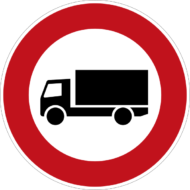 The round prohibition sign shows a truck and states that a general driving ban applies to all motor vehicles with a permissible total weight of more than 3.5 tons. The sign also applies to trailers and their towing vehicles. The only exceptions are cars and buses. So if your motor vehicle is heavier, you will not be allowed to drive through after this sign.
The round prohibition sign shows a truck and states that a general driving ban applies to all motor vehicles with a permissible total weight of more than 3.5 tons. The sign also applies to trailers and their towing vehicles. The only exceptions are cars and buses. So if your motor vehicle is heavier, you will not be allowed to drive through after this sign.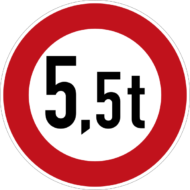
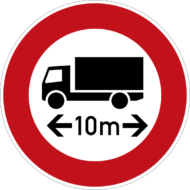 The last traffic sign with a red frame is about the length of your vehicle. Pictured is a truck as well
The last traffic sign with a red frame is about the length of your vehicle. Pictured is a truck as well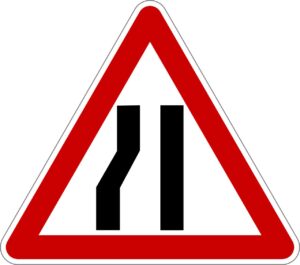 As the driver of a trailer, you must keep an eye on the traffic sign for narrow lanes, especially if your trailer is wider than your towing vehicle. In this case, drive a little more carefully into the bottlenecks or danger spots, drive slowly and use your side mirrors.
As the driver of a trailer, you must keep an eye on the traffic sign for narrow lanes, especially if your trailer is wider than your towing vehicle. In this case, drive a little more carefully into the bottlenecks or danger spots, drive slowly and use your side mirrors.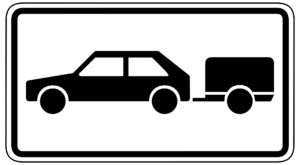
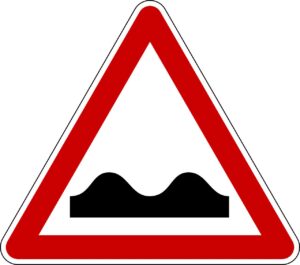 The traffic sign for uneven roads is important for you as a driver, because bumps in the road can cause the load to behave differently than usual. The load could come loose or start moving. In both cases, this also influences the handling of the vehicle combination. This is just one of the reasons why it is very important to always secure your cargo well. You can read about how best to do this in
The traffic sign for uneven roads is important for you as a driver, because bumps in the road can cause the load to behave differently than usual. The load could come loose or start moving. In both cases, this also influences the handling of the vehicle combination. This is just one of the reasons why it is very important to always secure your cargo well. You can read about how best to do this in 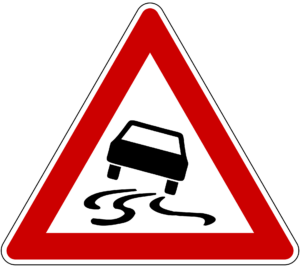 to adjust the driving style accordingly. When a trailer starts to slide, it can have very different effects. If the trailer simply slides forward, you as the driver must ensure that you also use the engine brake when braking. The reason is that your car will also slide more, since the weight of the trailer exerts additional force on the vehicle from behind. If the trailer shears out and slides sideways, dangerous situations can quickly arise. It is important for you to remain as calm as possible and to avoid hectic braking and steering maneuvers in any case.
to adjust the driving style accordingly. When a trailer starts to slide, it can have very different effects. If the trailer simply slides forward, you as the driver must ensure that you also use the engine brake when braking. The reason is that your car will also slide more, since the weight of the trailer exerts additional force on the vehicle from behind. If the trailer shears out and slides sideways, dangerous situations can quickly arise. It is important for you to remain as calm as possible and to avoid hectic braking and steering maneuvers in any case. Not only are pick-ups visually different, they are also not exactly ordinary in terms of their pulling power and their use. Pick-ups are mainly used in agriculture, the construction industry and forestry and are characterized by their large loading platform and their high towing power.
Not only are pick-ups visually different, they are also not exactly ordinary in terms of their pulling power and their use. Pick-ups are mainly used in agriculture, the construction industry and forestry and are characterized by their large loading platform and their high towing power. A special driver’s license is required for driving with a trailer. But is that always true? As a rule, you have to obtain a special trailer driver’s license and also take a driving test and a driving test. However, there is a special case for which you do not need a license and can still pull a trailer. You can also find out more about the common driver’s licenses for driving a trailer in Germany in our
A special driver’s license is required for driving with a trailer. But is that always true? As a rule, you have to obtain a special trailer driver’s license and also take a driving test and a driving test. However, there is a special case for which you do not need a license and can still pull a trailer. You can also find out more about the common driver’s licenses for driving a trailer in Germany in our  The detachable trailer hitch is a practical and convenient solution: If you want to drive the trailer for a short time, but do not necessarily always want to have a trailer hitch mounted on the vehicle, you can remove it at any time. A rigid ball bar does not offer this and can sometimes be a nuisance, for example when loading the car. Often, vehicle owners do not want to permanently drive around with an unused trailer coupling on the vehicle, as this is seen as an interference with the vehicle’s optics, depending on the model.
The detachable trailer hitch is a practical and convenient solution: If you want to drive the trailer for a short time, but do not necessarily always want to have a trailer hitch mounted on the vehicle, you can remove it at any time. A rigid ball bar does not offer this and can sometimes be a nuisance, for example when loading the car. Often, vehicle owners do not want to permanently drive around with an unused trailer coupling on the vehicle, as this is seen as an interference with the vehicle’s optics, depending on the model. Driving on a mountain, i.e. uphill or downhill, is still a challenge for many drivers even after driving school. With the trailer, it can be even more difficult, not least because of the additional weight. In this article we explain to you which points you should pay particular attention to when driving with a trailer on roads with slopes or inclines and how you can master these hurdles well.
Driving on a mountain, i.e. uphill or downhill, is still a challenge for many drivers even after driving school. With the trailer, it can be even more difficult, not least because of the additional weight. In this article we explain to you which points you should pay particular attention to when driving with a trailer on roads with slopes or inclines and how you can master these hurdles well. For transporting bicycles, the
For transporting bicycles, the 